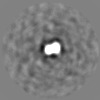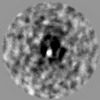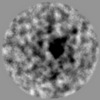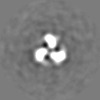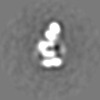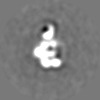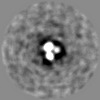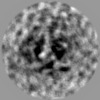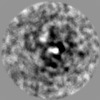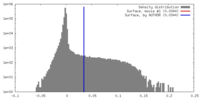[English] 日本語
 Yorodumi
Yorodumi- EMDB-7864: HIV-1 Envelope Glycoprotein clone PC64M4C054.SOSIP.664.N130A in c... -
+ Open data
Open data
- Basic information
Basic information
| Entry | Database: EMDB / ID: EMD-7864 | |||||||||
|---|---|---|---|---|---|---|---|---|---|---|
| Title | HIV-1 Envelope Glycoprotein clone PC64M4C054.SOSIP.664.N130A in complex with PCT64_13C Fab | |||||||||
 Map data Map data | HIV-1 Envelope Glycoprotein clone PC64M4C054.SOSIP.664.N130A in complex with PCT64_13C Fab, primary map | |||||||||
 Sample Sample |
| |||||||||
| Biological species |   Human immunodeficiency virus 1 / Human immunodeficiency virus 1 /  Homo sapiens (human) Homo sapiens (human) | |||||||||
| Method | single particle reconstruction / negative staining / Resolution: 30.0 Å | |||||||||
 Authors Authors | Berndsen ZT / Rantalainen K / Ward AB | |||||||||
 Citation Citation |  Journal: Cell Rep / Year: 2018 Journal: Cell Rep / Year: 2018Title: Co-evolution of HIV Envelope and Apex-Targeting Neutralizing Antibody Lineage Provides Benchmarks for Vaccine Design. Authors: Kimmo Rantalainen / Zachary T Berndsen / Sasha Murrell / Liwei Cao / Oluwarotimi Omorodion / Jonathan L Torres / Mengyu Wu / Jeffrey Umotoy / Jeffrey Copps / Pascal Poignard / Elise Landais ...Authors: Kimmo Rantalainen / Zachary T Berndsen / Sasha Murrell / Liwei Cao / Oluwarotimi Omorodion / Jonathan L Torres / Mengyu Wu / Jeffrey Umotoy / Jeffrey Copps / Pascal Poignard / Elise Landais / James C Paulson / Ian A Wilson / Andrew B Ward /  Abstract: Broadly neutralizing antibodies (bnAbs) targeting the HIV envelope glycoprotein (Env) typically take years to develop. Longitudinal analyses of both neutralizing antibody lineages and viruses at ...Broadly neutralizing antibodies (bnAbs) targeting the HIV envelope glycoprotein (Env) typically take years to develop. Longitudinal analyses of both neutralizing antibody lineages and viruses at serial time points during infection provide a basis for understanding the co-evolutionary contest between HIV and the humoral immune system. Here, we describe the structural characterization of an apex-targeting antibody lineage and autologous clade A viral Env from a donor in the Protocol C cohort. Comparison of Ab-Env complexes at early and late time points reveals that, within the antibody lineage, the CDRH3 loop rigidifies, the bnAb angle of approach steepens, and surface charges are mutated to accommodate glycan changes. Additionally, we observed differences in site-specific glycosylation between soluble and full-length Env constructs, which may be important for tuning optimal immunogenicity in soluble Env trimers. These studies therefore provide important guideposts for design of immunogens that prime and mature nAb responses to the Env V2-apex. | |||||||||
| History |
|
- Structure visualization
Structure visualization
| Movie |
 Movie viewer Movie viewer |
|---|---|
| Structure viewer | EM map:  SurfView SurfView Molmil Molmil Jmol/JSmol Jmol/JSmol |
| Supplemental images |
- Downloads & links
Downloads & links
-EMDB archive
| Map data |  emd_7864.map.gz emd_7864.map.gz | 2.8 MB |  EMDB map data format EMDB map data format | |
|---|---|---|---|---|
| Header (meta data) |  emd-7864-v30.xml emd-7864-v30.xml emd-7864.xml emd-7864.xml | 17.3 KB 17.3 KB | Display Display |  EMDB header EMDB header |
| FSC (resolution estimation) |  emd_7864_fsc.xml emd_7864_fsc.xml | 4.3 KB | Display |  FSC data file FSC data file |
| Images |  emd_7864.png emd_7864.png | 36.1 KB | ||
| Others |  emd_7864_half_map_1.map.gz emd_7864_half_map_1.map.gz emd_7864_half_map_2.map.gz emd_7864_half_map_2.map.gz | 2.8 MB 2.8 MB | ||
| Archive directory |  http://ftp.pdbj.org/pub/emdb/structures/EMD-7864 http://ftp.pdbj.org/pub/emdb/structures/EMD-7864 ftp://ftp.pdbj.org/pub/emdb/structures/EMD-7864 ftp://ftp.pdbj.org/pub/emdb/structures/EMD-7864 | HTTPS FTP |
-Validation report
| Summary document |  emd_7864_validation.pdf.gz emd_7864_validation.pdf.gz | 78.3 KB | Display |  EMDB validaton report EMDB validaton report |
|---|---|---|---|---|
| Full document |  emd_7864_full_validation.pdf.gz emd_7864_full_validation.pdf.gz | 77.4 KB | Display | |
| Data in XML |  emd_7864_validation.xml.gz emd_7864_validation.xml.gz | 495 B | Display | |
| Arichive directory |  https://ftp.pdbj.org/pub/emdb/validation_reports/EMD-7864 https://ftp.pdbj.org/pub/emdb/validation_reports/EMD-7864 ftp://ftp.pdbj.org/pub/emdb/validation_reports/EMD-7864 ftp://ftp.pdbj.org/pub/emdb/validation_reports/EMD-7864 | HTTPS FTP |
-Related structure data
| Related structure data |  7858C  7859C  7860C  7861C  7862C  7863C  7865C  7866C 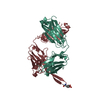 6ca6C 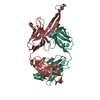 6ca7C 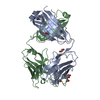 6ca9C  6dcqC C: citing same article ( |
|---|---|
| Similar structure data |
- Links
Links
| EMDB pages |  EMDB (EBI/PDBe) / EMDB (EBI/PDBe) /  EMDataResource EMDataResource |
|---|
- Map
Map
| File |  Download / File: emd_7864.map.gz / Format: CCP4 / Size: 3.8 MB / Type: IMAGE STORED AS FLOATING POINT NUMBER (4 BYTES) Download / File: emd_7864.map.gz / Format: CCP4 / Size: 3.8 MB / Type: IMAGE STORED AS FLOATING POINT NUMBER (4 BYTES) | ||||||||||||||||||||||||||||||||||||||||||||||||||||||||||||||||||||
|---|---|---|---|---|---|---|---|---|---|---|---|---|---|---|---|---|---|---|---|---|---|---|---|---|---|---|---|---|---|---|---|---|---|---|---|---|---|---|---|---|---|---|---|---|---|---|---|---|---|---|---|---|---|---|---|---|---|---|---|---|---|---|---|---|---|---|---|---|---|
| Annotation | HIV-1 Envelope Glycoprotein clone PC64M4C054.SOSIP.664.N130A in complex with PCT64_13C Fab, primary map | ||||||||||||||||||||||||||||||||||||||||||||||||||||||||||||||||||||
| Projections & slices | Image control
Images are generated by Spider. | ||||||||||||||||||||||||||||||||||||||||||||||||||||||||||||||||||||
| Voxel size | X=Y=Z: 4.1 Å | ||||||||||||||||||||||||||||||||||||||||||||||||||||||||||||||||||||
| Density |
| ||||||||||||||||||||||||||||||||||||||||||||||||||||||||||||||||||||
| Symmetry | Space group: 1 | ||||||||||||||||||||||||||||||||||||||||||||||||||||||||||||||||||||
| Details | EMDB XML:
CCP4 map header:
| ||||||||||||||||||||||||||||||||||||||||||||||||||||||||||||||||||||
-Supplemental data
-Half map: HIV-1 Envelope Glycoprotein clone PC64M4C054.SOSIP.664.N130A in complex with...
| File | emd_7864_half_map_1.map | ||||||||||||
|---|---|---|---|---|---|---|---|---|---|---|---|---|---|
| Annotation | HIV-1 Envelope Glycoprotein clone PC64M4C054.SOSIP.664.N130A in complex with PCT64_13C Fab, half map 1 | ||||||||||||
| Projections & Slices |
| ||||||||||||
| Density Histograms |
-Half map: HIV-1 Envelope Glycoprotein clone PC64M4C054.SOSIP.664.N130A in complex with...
| File | emd_7864_half_map_2.map | ||||||||||||
|---|---|---|---|---|---|---|---|---|---|---|---|---|---|
| Annotation | HIV-1 Envelope Glycoprotein clone PC64M4C054.SOSIP.664.N130A in complex with PCT64_13C Fab, half map 2 | ||||||||||||
| Projections & Slices |
| ||||||||||||
| Density Histograms |
- Sample components
Sample components
-Entire : HIV-1 Envelope Glycoprotein clone PC64M4C054.SOSIP.664.N130A in c...
| Entire | Name: HIV-1 Envelope Glycoprotein clone PC64M4C054.SOSIP.664.N130A in complex with PCT64_13C Fab |
|---|---|
| Components |
|
-Supramolecule #1: HIV-1 Envelope Glycoprotein clone PC64M4C054.SOSIP.664.N130A in c...
| Supramolecule | Name: HIV-1 Envelope Glycoprotein clone PC64M4C054.SOSIP.664.N130A in complex with PCT64_13C Fab type: complex / ID: 1 / Parent: 0 / Macromolecule list: all |
|---|---|
| Source (natural) | Organism:   Human immunodeficiency virus 1 Human immunodeficiency virus 1 |
| Recombinant expression | Organism:  Homo sapiens (human) / Recombinant cell: HEK293F Homo sapiens (human) / Recombinant cell: HEK293F |
-Macromolecule #1: HIV-1 Envelope Glycoprotein clone PC64M4C054.SOSIP.664.N130A
| Macromolecule | Name: HIV-1 Envelope Glycoprotein clone PC64M4C054.SOSIP.664.N130A type: protein_or_peptide / ID: 1 / Enantiomer: LEVO |
|---|---|
| Source (natural) | Organism:   Human immunodeficiency virus 1 Human immunodeficiency virus 1 |
| Recombinant expression | Organism:  Homo sapiens (human) Homo sapiens (human) |
| Sequence | String: MDAMKRGLCC VLLLCGAVFV SPSQEIHARF RRGARANNLW VTVYYGVPVW RDAETTLFCA SDAKAYDTEV HNVWATHACV PTDPSPQEIH LANVTEKFNM WKNSMVEQMH TDIISLWDES LKPCVKLTPL CITLACTNIT RKNVTGGNLT EDGKEELKNC SFNATTELRN ...String: MDAMKRGLCC VLLLCGAVFV SPSQEIHARF RRGARANNLW VTVYYGVPVW RDAETTLFCA SDAKAYDTEV HNVWATHACV PTDPSPQEIH LANVTEKFNM WKNSMVEQMH TDIISLWDES LKPCVKLTPL CITLACTNIT RKNVTGGNLT EDGKEELKNC SFNATTELRN KRQKVHSLFY RLDLVELNEG NSSNSNTSMY RLINCNTSAI TQACPKVSFE PIPIHYCAPA GFAILKCREE EFNGTGPCKN VSTVQCTHGI KPVVSTQLLL NGSLAEGTVK IRCENISNNA KTILVQLTTP VRINCTRPNN NTRTSIRIGP GQSFYATGDI IGDIRKAYCN VSGSEWKEAL GKVVVQLRSH FNKTITFASS SGGDLEITTH SFNCGGEFFY CNTSSLFNST WDGNSTTNST QEPNGTITLP CRIKQIINMW QRTGQAMYAP PIPGKIRCDS NITGLILTRD GENNNTESET FRPEGGDMRN NWRSELYKYK VVKIDPLGVA PTGCKRRVVE RRRRRRAVGI GAVLFGFLGA AGSTMGAASL TLTVQARQLL SGIVQQQSNL LRAPEAQQHL LRLTVWGIKQ LQARVLAVER YLSDQQLLGI WGCSGKLICC TTVPWNSSWS NKSQDEIWNN MTWLQWDKEI SNYTDTIYYL IEKSQNQQEV NEKDLLALD |
-Macromolecule #2: Immunoglobulin G PCT64-13C Fab, Heavy chain
| Macromolecule | Name: Immunoglobulin G PCT64-13C Fab, Heavy chain / type: protein_or_peptide / ID: 2 / Enantiomer: LEVO |
|---|---|
| Source (natural) | Organism:  Homo sapiens (human) Homo sapiens (human) |
| Recombinant expression | Organism:  Homo sapiens (human) Homo sapiens (human) |
| Sequence | String: EVQLVESGGG LVKPGGSLRL SCAASGFTFT NAWLDWVRQA PGKGLEWVGR IKSKTDGGTT DHAAPVKGRF TISRDDSKNT VYLQMNSLKI EDTAVYYCTT GVETYDFWSG YDDHYYDYYF KDVWGKGTTV TVSS |
-Macromolecule #3: Immunoglobulin G PCT64-13C Fab, Light chain
| Macromolecule | Name: Immunoglobulin G PCT64-13C Fab, Light chain / type: protein_or_peptide / ID: 3 / Enantiomer: LEVO |
|---|---|
| Source (natural) | Organism:  Homo sapiens (human) Homo sapiens (human) |
| Recombinant expression | Organism:  Homo sapiens (human) Homo sapiens (human) |
| Sequence | String: EIVLTQSPGT LSLSPGERAT LSCRASQSVS NNYLAWYQQK PGQAPRLLIY GASSRATGIP DRFSGSGSG TDFTLTISRL EPEDFAVYYC QQSARSFTFG PGTKVDIK |
-Experimental details
-Structure determination
| Method | negative staining |
|---|---|
 Processing Processing | single particle reconstruction |
| Aggregation state | particle |
- Sample preparation
Sample preparation
| Buffer | pH: 7.4 |
|---|---|
| Staining | Type: NEGATIVE / Material: Nano-W |
| Grid | Material: COPPER / Pretreatment - Type: PLASMA CLEANING |
- Electron microscopy
Electron microscopy
| Microscope | FEI TECNAI SPIRIT |
|---|---|
| Image recording | Film or detector model: TVIPS TEMCAM-F416 (4k x 4k) / Number real images: 222 / Average electron dose: 25.0 e/Å2 |
| Electron beam | Acceleration voltage: 120 kV / Electron source: LAB6 |
| Electron optics | Illumination mode: FLOOD BEAM / Imaging mode: BRIGHT FIELD |
| Experimental equipment | 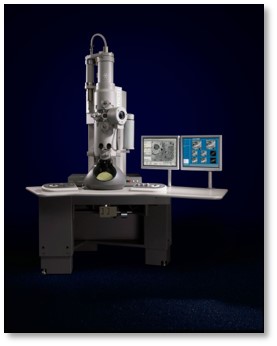 Model: Tecnai Spirit / Image courtesy: FEI Company |
 Movie
Movie Controller
Controller


 UCSF Chimera
UCSF Chimera





 Z (Sec.)
Z (Sec.) Y (Row.)
Y (Row.) X (Col.)
X (Col.)








